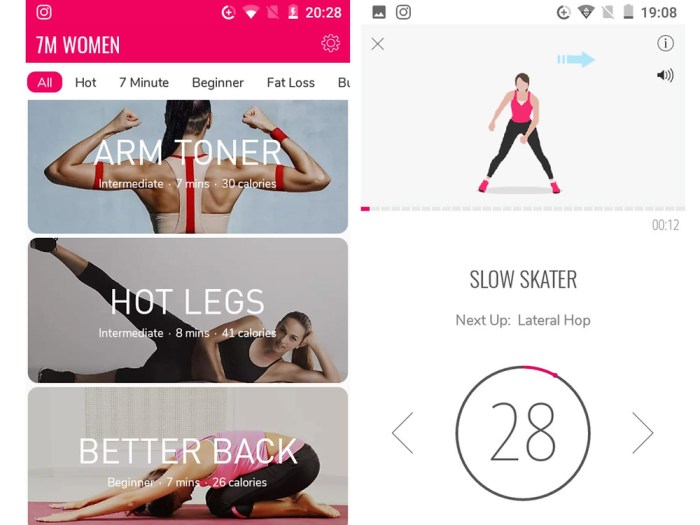Overview of Free Fitness Apps
Free fitness apps have become increasingly popular as a convenient and accessible way to track progress, stay motivated, and achieve fitness goals. They cater to a wide range of users, from absolute beginners to experienced athletes.
General Categories of Free Fitness Apps
Free fitness apps are broadly categorized based on their functionalities. Common types include workout tracking apps, guided exercise apps, nutrition tracking apps, and mindfulness apps. Each type offers specific features and benefits for different fitness goals.
User Types Served
Free fitness apps cater to a diverse user base. Beginners often benefit from structured workout plans and progress tracking, while experienced athletes might utilize advanced analytics and personalized training programs. Families and individuals with specific needs like pregnancy or injury recovery also find tailored options.
Common Features Across Free Fitness Apps
- Workout Tracking: Recording exercises, sets, reps, and weights.
- Progress Visualization: Graphs and charts showing fitness journey.
- Workout Scheduling: Setting reminders and planning sessions.
- Exercise Videos/Instructions: Visual guides for proper form.
- Nutritional Information: Food tracking and nutritional analysis.
- Motivational Elements: Challenges, rewards, and progress reports.
Comparison of Popular Free Fitness Apps
| App | Workout Tracking | Progress Visualization | Guided Workouts |
|---|---|---|---|
| Fitness App A | Detailed, with custom exercises | Comprehensive graphs, progress charts | Extensive library of guided workouts |
| Fitness App B | Basic, focused on exercise logs | Simple charts, basic progress tracking | Limited guided workouts, mostly bodyweight |
| Fitness App C | Comprehensive, integrates with wearable devices | Detailed charts, advanced metrics | Guided workouts for diverse fitness levels |
User Experience and Design
User interface (UI) and user experience (UX) are critical to the success of free fitness apps. A well-designed app encourages engagement and motivates users to stick with their fitness journey.
Importance of UI/UX in Fitness Apps
Intuitive navigation, clear instructions, and aesthetically pleasing design elements significantly impact user engagement and motivation. A seamless user experience is crucial for long-term adoption.
Impact of Design on User Engagement
Design elements like color schemes, typography, and layout contribute to the overall user experience. A user-friendly interface fosters confidence and encourages consistent use.
Comparison of User Experiences
Different fitness apps offer varying levels of ease of use and navigation. Some apps are straightforward and easy to use, while others may require a learning curve. The overall user experience greatly impacts user satisfaction and adherence to the app’s use.
Key Design Principles
| Principle | Good Practice | Bad Practice |
|---|---|---|
| Clarity | Clear instructions, easy-to-understand icons | Vague instructions, confusing icons |
| Simplicity | Minimalist design, intuitive navigation | Cluttered interface, complex navigation |
| Consistency | Uniform design elements across the app | Inconsistent design elements, confusing visual hierarchy |
Features and Functionality
Free fitness apps offer a wide range of features that cater to diverse needs and preferences. These features enhance the overall fitness journey by providing structure, motivation, and tracking capabilities.
Common Features
- Workout tracking and progress visualization.
- Guided workouts and exercise tutorials.
- Nutritional tracking and meal planning.
- Community features (forums, challenges).
- Integration with wearable devices.
- Motivational elements like rewards and badges.
Effectiveness of Workout Types
Guided workouts provide structure and guidance, while exercise tracking allows users to monitor their progress. Motivational elements like challenges and rewards play a significant role in user engagement and adherence.
Workout Tracking Methods
Various methods exist for tracking workouts, including manual input, integration with wearable devices, and automatic recognition of movements. Different visualization methods, like graphs and charts, help users understand their progress.
Motivational Elements

Challenges, rewards, and badges enhance user motivation. Personalized feedback and progress reports can also play a key role in encouraging consistent participation.
Comparison of Features by Category
| App Category | Workout Tracking | Nutrition Tracking | Community Features |
|---|---|---|---|
| Basic | Simple logs | Basic food input | Limited forum |
| Advanced | Detailed logs, metrics | Comprehensive nutrition analysis | Active forums, challenges |
Epilogue
In conclusion, free fitness apps offer a valuable resource for achieving fitness goals. While user commitment and consistency are crucial for positive results, the availability of various apps, coupled with diverse features and monetization strategies, makes the journey more accessible. Navigating the digital landscape of fitness apps requires understanding the crucial elements of user experience, app store presence, and security. This guide has provided a comprehensive overview of these key aspects, empowering you to choose the right tool for your personal fitness journey.